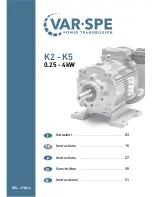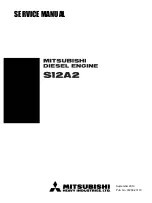
Brake connection via external power supply
Y circuit
∆
circuit
Brake connection
Pole changing
Low rpm High rpm
Y
circuit Y
circuit
Pole changing Dahlander connection
Low rpm
∆
circuit
High rpm
Y Y
circuit
1-4
Brake
10-11 Tripping PTC
Pre-alarm PTC
Use tripping device with PTB number
12-13
Tripping PTC
70-71 Space
heater
P1-P2 Temperature monitoring: Microtherm T 10
For a rapid
engagement
of the brake
(DC-voltage
side tripping)
bridge 3-4
can be re-
placed by a
contact. The
contact must
be tripped
simultane-
ously with
Brake power
supply via
terminals 1-2.
Observe the
voltage data
on the rating
plate. Termi-
nal 3-4 must
3 Operation and Repairs
Duty types and thermal protection
• In S1 duty class motors a temperature sensor (TS) can be used in addition to the motor circuit breaker as required
by DIN EN 60079-14, VDE 0165.
• If in S1 duty cycle motors protection is to be provided against overheating only by means of the TS, a proven combi-
nation of TS and tripping device is to be used for said purpose.
• In the case of non-S1 duty cycle motors proven combinations of TS and tripping device must be used as protection
against overheating.
• The supplying of power to the motors via the frequency converter is permissible only if a proven combination of TS
on the windings and tripping device is used.
Special operating conditions
The operating of the motors at ambient temperatures outside the generally valid range of –20 to +40 °C is allowed also
without heater if an appropriate temperature range – e.g. –55 °C <
T
amb
< 60 °C – is specified on the rating plate.
Operation at less than –20°C is allowed also without any additional indication if the temperature of the entire motor is
maintained at least at -20 °C by means of a space heater.
At motor temperatures of less than -20°C the heater must not be started, as these are not explosion-protected.
Heat input through the driven machine
It must be ensured that no quantities of heat greater than the maximum heating values specified in table are conveyed
from a mounted machine to the interface with the motor (e.g. shaft and motor flange). This way it is guaranteed that no
point of the motor exceeds the temperature class.
Table 9: Permissible surface heating at an ambient temperature of 40°C:






































